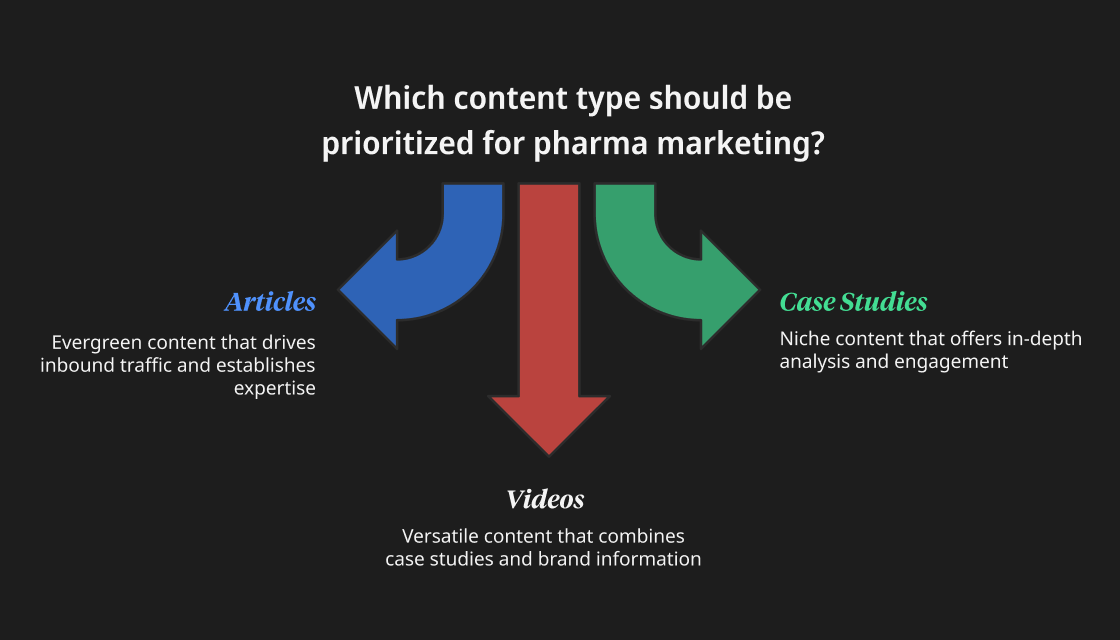by Kadambari Bendre
6 minutes
How to Create Valuable Content in Pharma Marketing
Explore the role of content marketing in pharma, creating value through trust, education, and patient-focused strategies.

The pharmaceutical industry is a unique space where scientific and medical breakthroughs meet stringent regulations. People worldwide turn to the internet to understand medical information. To fulfill this need, pharmaceutical companies must carefully select their marketing strategies because they must provide relevant medical information in simple words while complying with regulatory guidelines regarding medical products. This makes content marketing for pharma challenging.
Informative marketing allows pharmaceutical companies to provide scientifically correct, relevant and optimized information to their audience, primarily healthcare professionals, patients and educators. Moreover, an essential part of informative marketing is creating value through content. However, the role of content marketing in pharma is often unclear.
Let’s dive into the blog to unravel the details…..
The role of Content Marketing: How does content marketing provide value to customers?
Here’s how pharmaceutical companies can promote creating value through content:
Building trust and credibility
Pharmaceutical companies operate in a strictly regulated industry where each word holds tremendous value and influences patients, making trust important. Informative marketing involves providing accurate, up-to-date, and evidence-backed information to readers. It also involves opening and maintaining transparent communication channels with customers. These practices highlight the company’s commitment to ethical practices and patient safety, building trust and credibility for stakeholders and customers. An excellent example is the Mayo Clinic, an American medical centre with an internationally recognised website used by millions.
Educating stakeholders
Content marketing in pharma also aims to educate stakeholders, such as patients, clinical trial volunteers, doctors and nurses, about diseases and treatment options. The published content includes detailed information on medical conditions, new therapies and treatment options, guidelines and best practices, all of which improve the knowledge of medical practitioners and patients.
Improves patient outcomes
Improving patient outcomes is another way of creating value through content in pharma. By creating and publishing informative content, pharmaceutical companies assure patients that their doctor recommends the right therapy. Consequently, patients are more likely to follow the prescribed treatment plan, medication timeline, and other therapies recommended, eventually resulting in better patient outcomes.
Consequently, content positions pharmaceutical companies as trustworthy and reliable brands, encouraging people to seek out the company’s products or services during medical emergencies. Therefore, developing unique pharma marketing strategies and appropriately implementing them can significantly impact the brand’s reputation among healthcare professionals and patients.
Creating valuable content: How do you create valuable content in pharma marketing?
It is necessary to understand that pharma marketing content has significantly more impact than any other marketing content. The reason is simple: readers often take this content as medical advice.
Consider the following scenario: A person visits a dentist because of toothache. After diagnosis, the dentist recommends specialized toothpaste, which is more expensive than regular. The person returns home, searches for the product online, and tries to understand its effects and efficacy based on online information. We’ve all done this at least once, maybe not with a dentist’s prescription but for a general practitioner’s or an orthodontist’s. This shows the true impact of pharma marketing content. Ultimately, the patient may choose to buy (or not buy) the product or go through with the treatment based on the online blogs.
Hence, creating high-quality, transparent, easy-to-understand content for pharma marketing strategies is necessary. Here are some guidelines to this end:
Be transparent about information.
To create value through content, the content should be unbiased. The published content should be transparent regarding all medical information – the good and the bad. Product-related content should also include side effects; they should not be pushed to the end of the content with an asterisk at the relevant space.
Don’t oversell the product.
The focus should be on creating informative content instead of product-centric content. Ideally, the article should increase the reader’s knowledge instead of making them purchase the product. The product placement is critical; it should be appropriately included with all necessary information without taking away attention from the disease or treatment.
Create in-depth content.
In pharma marketing strategies, the published content should focus on creating value. The information should be complete. When writing articles regarding a disease, all symptoms, treatment options, and precautions should be included in one place for easy understanding; creating side links may improve website engagement but not create value for customers who view it as incomplete content.
Get involved with leaders.
An excellent way of creating value through content in pharma is to get involved with leaders and stakeholders. Contact pharma executives, doctors, patients and other personnel to obtain real-life details. Using these connections, create case studies that are authentic and realistic. The audience can connect with these situations, improving reach and engagement.
The primary focus of pharma content should be value generation instead of website engagement; it should improve patient adherence and outcomes instead of sales. Hence, creating appropriate content is necessary. While various types of content are currently used for marketing, they are not all ideal for pharma marketing strategies.
Which type of content should be published for pharma marketing?
Pharma marketing strategies should focus on the following content types:

Articles
Medical articles are easy to read and generate inbound traffic for the company’s website. If written correctly, most articles in the pharmaceutical space are evergreen because medical information is relevant to some person in some corner of the world at some time. However, to create value through articles, they should be written by subject matter experts. An excellent example is WebMD, which exclusively publishes articles on medical information and has established itself as a brand that people worldwide can turn to for any medical information.
Case studies
Medical case studies allow you to delve deeper into a medical issue, analyse it from different angles and provide solutions. Pharmaceutical companies can publish case studies regarding patients and the company's journey to developing a particular product. Most companies often publish PR articles or white papers regarding their achievement. Therefore, such case studies are rarely published by any pharmaceutical company, making this a niche space companies can exploit for engagement.
Videos
Videos are another form of content that can be exploited to attract the audience's attention. Videos can be of various types: informational videos, case studies, news, and brand information. However, one area where pharma marketing strategies can genuinely stand out is combining case studies and brand information. Pharmaceutical companies can create videos or a video series explaining their journey to developing a particular product. For example, The Road to a COVID-19 Vaccine is a YouTube series that showcases Johnson & Johnson’s journey to developing their COVID-19 vaccine. In contrast, Pfizer’s YouTube series Our Science details the actual science behind their technologies.
These three mainstream content types can be easily exploited to attract customer attention and build a visible brand. Content marketing in pharma can easily showcase the value of a company’s efforts and build a brand reputation.
Conclusion
Various regulatory guidelines restrict content marketing in pharma, but even under these restrictions, pharma companies can develop meaningful and relevant content. This article has highlighted the impact of pharma content and provided simple guidelines to build pharma marketing strategies. In light of how competitive and sensitive this industry is, content marketing should be a key focus because it can attract an organic audience and make a real difference in patients’ lives.
FAQs
1. What are the best types of content in the pharmaceutical industry?
Articles, white papers, case studies, videos, presentations, original research, interviews, and webinars are the best ways of creating value through content in the pharmaceutical industry.
2. Who is the target audience of pharma marketing strategies?
Content marketing in pharma targets healthcare professionals (e.g., doctors, nurses, practitioners, and other providers), patients, caregivers, and stakeholders.
3. Are pharma marketing strategies subject to regulatory approvals?
Yes, regulatory bodies like the EMA, FDA, and other local bodies strictly regulate content marketing in pharma. Marketing content has to comply with these guidelines to ensure the company has no legal liabilities





